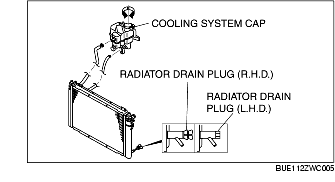ENGINE COOLANT REPLACEMENT [L3]
id0112008006a1
-
Warning
-
• Never remove the radiator cap or loosen the radiator drain plug while the engine is running, or when the engine and radiator are hot. Scalding coolant and steam may shoot out and cause serious injury. It may also damage the engine and cooling system.
-
• Turn off the engine and wait until it is cool. Even then, be very careful when removing the cap. Wrap a thick clean rag around it and slowly turn it counterclockwise to the first stop. Step back while the pressure escapes. When you are sure all the pressure is gone, press down on the cap using the clean rag, turn it, and remove it.
1. Remove the cooling system cap.
2. Remove the splash shield (LH).
3. Loosen the radiator drain plug and drain the engine coolant.
4. Tighten the radiator drain plug.
-
Tightening torque (L.H.D.)
-
1-2 N·m {11-20 kgf·cm, 9-17 in·lbf}
-
Caution
-
• Use engine coolant at a concentration that meets the environmental conditions in which the vehicle is driven, otherwise engine damage could occur.
5. Pour the coolant into the coolant reserve tank up to the coolant filler port.
6. Tighten the cooling system cap.
-
Caution
-
• If the coolant temperature becomes too high, stop the engine to prevent it from overheating.
7. Start the engine and let it idle until the cooling fan operates.
8. After engine warms up, perform the following steps.
-
(1) Run the engine at 4,000 rpm for 1 min.
-
(2) Run the engine at idle for 1 min.
-
(3) Repeat Step (1), (2) approx. two times.
-
(4) Turn the heater on and verify that warm air flows from the ventilation grill.
9. Stop the engine and wait until the coolant temperature decreases.
10. Check the coolant level. (See ENGINE COOLANT LEVEL INSPECTION.)
11. Inspect for coolant leakage. (See ENGINE COOLANT LEAKAGE INSPECTION.)
